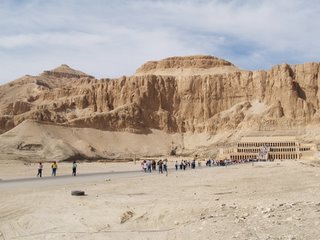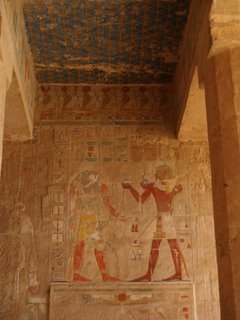
These are the Theban Hills and the Temple of Hatshepsut is on one side (the side facing the Nile River) and the other side is where the Valley of the Kings lies.

The Hatshepsut Temple, built during her co-reign (1473-1458 BC) with Tuthmosis II (her half brother and husband), who took over after his death, is magnificent to look at today. It has a modern look to it, even today.

Tuthmosis III removed Hatsheptsut's face off of many statues after her death, not from anger but to make him the sole pharoah. Hatshepsut gained her power because her husband (Tuthmosis II) died and she was the first female pharoah. Another FYI, most pharoahs married their sisters and half-sisters and Hatshepsut and Tuthmosis II were no exception. Later in Hatshepsut's reign she started to have herself depicted as a male, since pharoahs were depicted as males. She did not present herself as a male, in person, just as a male figure to symbolize her power.

To the right of the ramp, 2nd level, is the Chapel of Anubis. This photo shows Tuthmosis III (Hatshepsut's heir apparent) making offerings to the sun god Ra-Harakhty. There are many colorful murals in this chapel depicting food, breads, animals and other gifts to the gods.
By the way, it is called the Hatshepsut Temple at Deir al-Bahri, which means "Northern Monastery". Monastery? Yes, after the reign of the pharoahs, Christians turned it into a monastery. This temple, which is undergoing extensive reconstructions, was destroyed not only by Christians, but by pharoahs following Hatshepsut's reign.

No comments:
Post a Comment